Cancer
Diaries
Part Four:
Royal Rife
Written by
Rick Archer
September 2013
Forward
I have made little
effort to disguise my shock and contempt for the people who have
gone out of their way to suppress natural cures for cancer. In
their desperate attempt to hang onto the existing ineffective and
quite painful chemotherapy-radiation-surgery treatment commonly used
today, millions have died and millions have suffered. Their
motive appears to be money, the so-called root of all evil.
In the process, I have
been accused of maligning the Medical Establishment.
I grow weary of having you repeatedly malign the motives of "the
medical establishment" and the intelligence and the commitment
to the health of their patients of physicians who do not agree
with your point of view.
If I given anyone else a
similar impression, please accept my profound apology. My
Cancer Diaries are hardly an indictment of the entire Medical
Community.
|
 |
| |
Who Are the
Guilty Ones?
When I rail against the
"Medical Establishment", in truth I speak of only a handful of
shadowy, morally-bereft human beings whose greed has caused them to
systematically impede the search for an alternative cure for cancer
for over eighty years.
Just to help keep track,
Chapter One covered the
creative spark for these cancer diaries. It all began in 2012
with a perfect storm combination of events. First came my daughter's involvement in
raising funds for cancer research, then came my brother-in-law's losing fight
with cancer using conventional methods, and then came the scathing criticism from
a friend, Mr. Skeptical, who berated me for supporting mainstream
cancer treatment.
Mr. Skeptical pointed me
to a documentary
Cancer - the
Forbidden Cures. That video was an eye-opener to put
it mildly. This video became the inspiration for
Chapter Two. After
detailing the woes associated with Essiac, Hoxsey, Gerson, and
Laetrile, I intended to stop right there.
However, just before I
could shut the door, the amazing story of Stanislaw Burzynski's
harassment appeared before my eyes. Shocked and appalled, I
revealed the details of his Promethean struggles in
Chapter Three.
It really seems to me
like the more I learn, the worse it gets. There seems to be no
end to further stories of alternative cancer cures that were
suppressed. Gerd Hamer, Shark Cartilage, Mistletoe, Tullio
Simoncini (baking soda), W.F. Koch (glyoxylide), Emanuel Revici,
Gaston Naessens (714-X), Ernest Krebs (laetrile), Antoine Prioré,
Virginia Livingston-Wheeler, Krebiozen, Luigi de Bella, Coley's
Toxins, Issels Treatment, Johanna Budwig (diet), Johanna Brandt
(grapes), Ghadiali, and Nicholas Gonzalez. The list just keeps growing.
Every single story reads
virtually the same way. A health practitioner observes
something that works and investigates. To their surprise, it
appears to cure cancer. Anecdotal stories emerge of patients
condemned to die by conventional doctors who are magically cured. They sing the praises of their heroes.
Everyone is happy until
the bad guy shows up. Some thug representing organized
medicine inevitably spoils the party and all hell breaks loose.
The practitioner is ostracized by their peers, denied publication,
ridiculed by leading medical authorities, and debunked in quackwatch.
Some are even taken to court, the 'ultimate compliment'.
The healer's life is
ruined and patients are shocked at how their savior was treated.
And then someone writes stories of conspiracy and persecution on the
Internet. And then eventually I stumble on it and get more
disgusted.
I can't possibly
validate each story. I get familiar with what happened, then
file it away for future reference. But once in a while, I take
a step back and look at the big picture. The one thing that
always sticks in the back of my mind is this:
Where there's
smoke, there's fire.
|
 |
Or is there fire?
Is it all just my imagination? Maybe!! After
all, every single one of the cures I listed above has been debunked
in Wikipedia. Every single cure is listed on Quackwatch.
If you don't want to take my word for it, pick one at random and
look for yourself.
I picked one cure I
didn't know much about at random and found a fun anecdote. It
was written by William Kelley Eidem, author of "The Doctor Who
Cures Cancer". Eidem's hero was a doctor named Emanuel
Revici. Eidem has this quote:
"Dr. John
Heller had been the medical director of Sloan Kettering for ten
years. One day he told me he had known of Revici for ten
years. He then went on to say he'd seen people walk in
dead and walk out alive from Revici's clinic. Heller added
that he didn't know how Revici did it. Heller's
Sloan-Kettering office was only blocks from Revici's clinic, yet
in ten years not once did he ever bother to visit to find out
the answer. Heller never did find a cure for cancer, nor
did Sloan-Kettering." [
source
]
No matter which therapy
one chooses to investigate, assume this alternative cure will have a
long line of detractors. And yet every one of the stories has
amazing tales to tell of how well the cure really did work till they
shut it down. This basic contradiction exists in every single
story.
So who is right and who
is wrong?
Don't ask me, I am the
guide, not the source. The one thing I can say is that I
believe every single one of these stories really did take place.
Every single story comes complete with pictures, dates, names,
places, events, anecdotes, patients speaking on camera, plus
detailed explanations of how the therapy was supposed to work.
And then Wikipedia announces the cure has been debunked, so it is
officially discredited.
Although I cannot say
which of these various alternative cures actually worked or not,
what I can say is I believe every single one of these people exist
or existed and that they were all treated miserably in the process
of trying to help cure people.
I am serious. No
one goes to all the trouble of writing these horrible tales of woe
unless they are upset and in pain. Ask me. I should
know. I did not begin writing these cancer articles because I
was bored and randomly picked 'medicine' out of a hat to write mean
tirades about. I began because I was deeply upset about my
brother in law's imminent death and determined to look for answers.
|
These stories
have been written by people who think an injustice has been
done. On the right is an example of what I am talking
about. It was written by an "Essiac" practitioner. Is
it true? Beats me, but it is interesting.
Once I got
immersed in the story of alternative cure suppression, it
just kept getting worse... and worse... and worse. I
am now convinced there is no end to the bottomless pit of
stories alluding to abuses and corruption.
Oh, sure, there
can be no doubt somebody exaggerated a tale or added a fib
here and there, but in the end one overriding truth emerges:
From
the stories floating around on the Internet, it becomes
increasingly obvious that certain individuals
representing the Medical Establishment have spent the
past eighty years going to extraordinary lengths to
eradicate several potential cures.
Stanislaw
Burzynski, the focus of my previous story, is simply the
latest in a long line of people who have been persecuted.
But here's a
shocker. In some ways, this next story might be the
worst. Out of all of the "alleged" cures for cancer, this is
the one that probably worked.
|
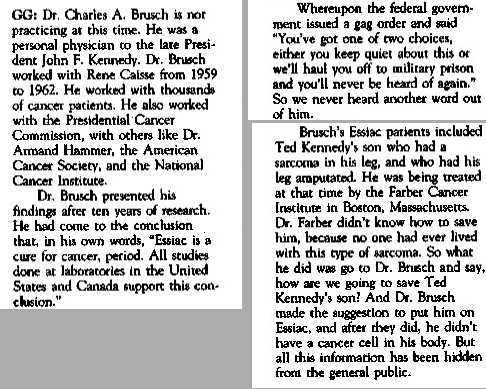 |
|
|
|
Royal Rife
|
On a personal note, I assumed that after reading of the
Burzynski trials, I had heard the worst of it. I
was wrong. This story depressed me terribly.
I will begin by asking an
interesting question.
What do you suppose
would happen to a man who was able to discover a cure for every
disease under the sun? Pick one of the following
choices:
- His Name would appear
in the Headlines of Every Newspaper in the Land
- He would be be proclaimed
Man of the Year, Century, AND the Millennium
- Articles
celebrating his Genius would be found in every Magazine
- He would appear on
every Talk Show imaginable for a solid month to explain how he
did it
- His life would be ruined
and he would completely disappear from sight
|
Considering you have
never even heard of this guy, I think you already have a useful
clue. So let's see what happened.
Here is Royal Rife
in a picture taken back in the 1930s. He doesn't look very
scary. Roy Rife was both a microbiologist and an optical engineer.
Dr. Rife invented an
ingenious microscope that appears to have been light-years ahead of
anything like it.
In the 1930s, he claimed that by using a
specially designed optical microscope, he could observe a number of
microbes which were too small to visualize using previously existing
technology.Rife also reported that a
'beam ray' feature of his invention could
weaken or destroy the pathogens by energetically exciting
destructive resonances in their constituent chemicals.
|
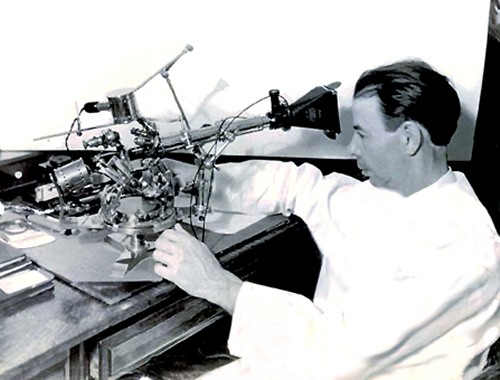 |
So was this contraption
of any value? Of course not.
Wikipedia writes it off as a huge waste of time.
Rife's
claims could not be independently replicated, and were
ultimately discredited by the medical profession in the 1950s.
Rife blamed the scientific rejection of his claims on a
conspiracy involving the American Medical Association (AMA), the
Department of Public Health, and other elements of "organized
medicine", which had "brainwashed" potential supporters of his
devices.
Thank goodness we have
Wikipedia, the magazine of the FDA. It says this Rife quackpot blamed his rejection on
a conspiracy involving the AMA and the Medical Establishment.
Oh yawn. Where have we heard that before? And oh how
tiresome it must be for the readers to hear of yet another absurd
"alternative cancer cure" claim. Who can even keep track of
them all??
Well, you know how
curious I can be. Once I discovered Rife was a graduate of
Johns Hopkins, my alma mater (Go Blue Jays!), I decided maybe I
should look a little further.
|
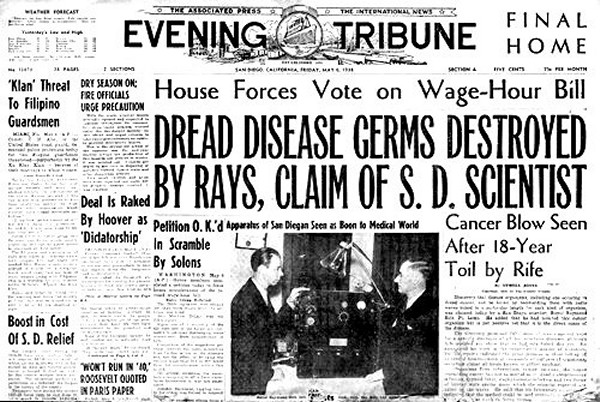 |
|
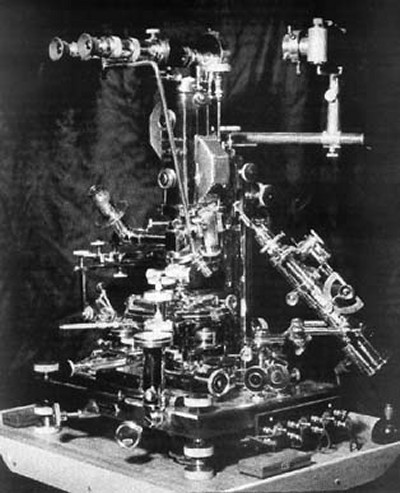 |
According to the 1987
book, The Cancer Cure That Worked, by Barry Lynes, Rife was
an optical engineer and technician of great skill. His first success
was the building of the Universal Microscope in the late 1920s.
One thing that doesn't
seem to be in any doubt is that Royal Rife was a genius.
In addition to his
Universal Microscope and subsequent
Frequency Instrument,
Rife's inventions include a
heterodyning ultraviolet microscope, a microdissector, and a
micromanipulator. Now try naming all those
instruments in one breath.
Royal Rife
received 14 major awards and honors and was given an honorary
Doctorate by the University of Heidelberg for his work. During the
66 years that Rife spent designing and building medical instruments,
he worked for Zeiss Optics, the U.S. Government, and several private
benefactors. His most notable
patron was millionaire Henry Timkin, of Timkin
roller bearing fame.
Because Rife was self-educated in so many
different fields, he intuitively looked for his answers in areas
beyond the rigid scientific structure of his day. He had mastered so
many different disciplines that he literally had, at his
intellectual disposal, the skills and knowledge of an entire team of
scientists and technicians from a number of different scientific
fields. So, whenever new technology was needed to perform a new
task, Rife simply invented it. Most of
these machines he built himself.
Everything written about
Rife underscores that this guy was beyond brilliant.
|
Early Career
Rife was born in 1888 in
Elkhorn, Nebraska. His father was a mechanical engineer.
His early life was marked by the loss of his mother when he was
eight months old. Rife was an only child at this point.
His father worked too many hours and traveled far too much to care
for a helpless infant, so Rife was sent to be raised by his father's sister.
In 1905, Rife attended
Johns Hopkins University in Baltimore, Maryland, an institution
famous for its medical school. Originally intending to become
a doctor, Rife discovered he was more interested in studying
bacteriology. He did graduate work in Germany at the
University of Heidelberg. He spent many hours photographing
specimens for the University. This led to a deeper interest in
optics. Because his interest in bacteriology required the
intensive use of microscopes, Rife found himself continually
frustrated by the limits of the machines he worked with.
Consequently, he sought
out a research internship with Zeiss Works, the leading manufacturer
of microscopes in the world. Rife, a brilliant student, soon
came under the tutelage of Hans Luckolt, the senior engineer.
This training allowed Rife
to become a master of microscope and lens technology.
His education complete,
in early 1912 Royal Rife moved to Point Loma, a suburb of San Diego.
He met Mamie Quinn, a woman of Chinese descent. Obviously
there was existing prejudice at the time, Rife
could not have cared less about her Chinese heritage. Rife
married Ms. Quinn in 1912, the same year he met her.
Although they were never able to have children, the marriage was a
happy one. Rife received tremendous support and encouragement from
Mamie. It was her watchful eye that gave Rife the shelter to
immerse himself deeply into the world of ideas. The marriage lasted
45 years until his wife's passing in 1957.
|
From 1915 till 1920,
Rife worked in his private lab identifying and classifying
disease-causing microorganisms. He was continually frustrated
at the limits of viewing magnitude, so he began to design his very own
super microscope.
By 1920, Rife had finished building the world's first virus
microscope. He didn't stop there. By 1933, he had perfected
even better technology.
Now he
constructed the incredibly complex Universal Microscope,
which had nearly 6,000 different parts and was capable of magnifying
objects 60,000 times their normal size. With this incredible
microscope, Rife became the first human being to actually see a live
virus.
Rife was thus able to see otherwise
invisible organisms and watch them actively invade
tissue
cultures. Rife
was able to view the living cancer virus at work. His microscope used many
quartz prisms and lenses, placed to compensate for losses of
refraction due to air. This enabled him to view far tinier particles
than had ever been seen before. Rife was the first man to ever view this
intricate hidden world.
Accordingly to one
source, until quite recently, the Universal
Microscope was the only one which was able view live viruses.
Apparently modern electron
microscopes instantly kill everything beneath them, viewing only the
mummified remains and debris.
What the Rife microscope could
see was the bustling activity of living
viruses as they change form to accommodate changes in environment,
replicate rapidly in response to carcinogens, and transform normal
cells into tumor cells.
Even Rife's detractors
admit he put together an impressive microscope. What makes him
special is that he also had the training as a medical researcher to
know what he was looking at and to know what to do about it.
|
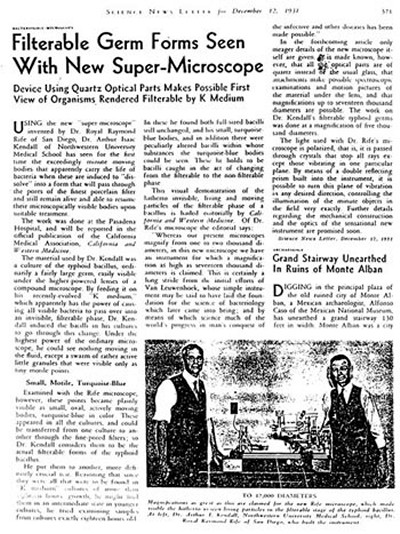 |
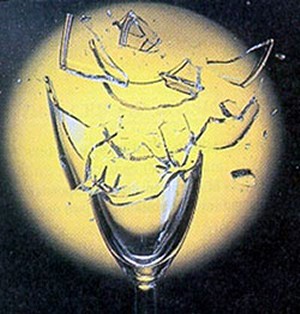 |
In other words, Rife had the genius of an Edison to first
know how to build this super-machine AND THEN he had the
genius of a Pasteur to know what to do with what he was
seeing!
Rife's next amazing
discovery was to develop a way to kill the viruses. He used a technique he called
"Coordinated Resonance". Apparently each microbe has an
electronic frequency where it is vulnerable to vibrations.
Rife would simply shatter the microbes using concentrated radio rays!
Using the Universal
Microscope, Rife observed cancer viruses as they changed their size
and form. He discovered that exposing a virus to certain frequencies
of radio waves killed it quickly. Years of experimentation led the invention of the
Frequency Instrument, or Frequency Beam Ray, a device that produced
the exact frequencies needed to destroy viruses.
Rife noticed that when
he played back their own pattern of oscillation, slightly modified,
he could destroy the viruses without affecting the healthy tissues around them.
This caused the bacteria or virus to shatter in the same manner as a
crystal glass breaks in response to the voice of an opera singer. [
source ]
|
|
(Rick Archer's Note: Does any of
that description make sense to you? I found several
far more technical explanations on the Internet that would
delight anyone with the mind of an engineer, but it was all
Greek to me. You would have to ask my father to explain
it. He was the engineer in the family, I was merely the
Social Science disappointment. Family joke.
Since I do not have the
scientific background to share this information any better, I
have a suggestion. Why not take a brief detour?
I found a marvelous explanation on a
10 minute
Rife video that shows how Rife's inventions worked.
You can see all the evil little cancer microbes swimming around
and then get to watch the cancer virus shrink before your eyes.
You also get to hear
Dr. Rife himself explain how it worked. Very fascinating
to hear him speak.)
|
What Rife saw, as did
the other microbiologists who later used his instruments, was
astounding. It shook the established theories of medicine to
their roots.
It took Rife many years,
working 48 hours at a time, until he discovered the frequencies
which specifically destroyed herpes, polio, spinal meningitis,
tetanus, influenza, and an immense number of other dangerous disease
organisms... and cancer as well. One
source
claims this microscope could kill everything under the sun.
Although the biologists
of his day were impressed with the power of this invention, both the
medical community and the optical physicists would have little to do
with Rife. There were no principles in physics to explain how
the Universal Microscope worked. That was all the reason they
needed for them to reject Rife's ideas. The medical community made sure to criticize the work of Rife to
anyone who would listen.
To be honest, Rife's
discoveries were so unbelievably profound, the genius of his work
probably went right over their heads. Microbiologist E.C.
Rosenow tried to explain Rife's principles to his colleagues, but
got nowhere. He was philosophic about the lack of acceptance for
his findings among his colleagues. Rosenow told his son:
"There
is no way to convince
one's peer group of something new until their attitude of
receptivity changes. They simply won't listen."
This thought echoed Max
Planck, the German Nobel laureate in physics, who stated that for
new ideas to be accepted, one had to wait for a generation of
scientists to die off and a new one to replace it.
Fortunately, however, not everyone was so close-minded. In 1934,
people in California who knew Rife personally decided it was time to put
this weird technology to a test.
|
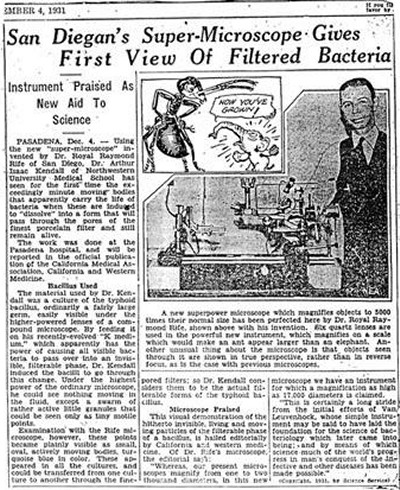 |
|
|
|
|
The 1934 USC
Experiment
As the newspaper
clippings suggest, Rife was a definite hometown hero in San Diego.
Everyone agreed his microscope was amazing. At this point the
man had no enemies. Royal Rife was the toast of the town.
On November 20, 1931,
forty-four of the nation's most respected medical authorities
honored Royal Rife with a banquet billed as The End To All
Diseases at the Pasadena estate of Dr. Milbank Johnson.
What a great evening it must have been.
But by 1939, almost all
of these distinguished doctors and scientists were denying that they
had ever met Rife. What had happened to make so many brilliant men
have complete memory lapses? One might ask if that fancy
microscope could cause amnesia as well.
In 1934, the University
of Southern California appointed a Special Medical Research
Committee to bring terminal cancer patients from Pasadena County
Hospital to Rife's San Diego Laboratory and clinic for treatment.
The team included doctors and pathologists assigned to examine the
patients - if still alive - in 90 days.
The diseased people were exposed to the exact same frequencies that
had been seen through the microscope to destroy the virus causing
their illness. Treatments lasted only three minutes. The person
would wait three days before another exposure. This gave the lymph
system time to cleanse the dead virus from their bodies. Unlike the
chemotherapy treatments currently in use, Rife's therapy was 100
percent effective and engendered no adverse symptoms. One
should also note it wasn't painful to be treated.
After the 90 days of
treatment, the Committee concluded that 14 of the 16 patients had
been completely cured. The treatment was then adjusted. This did the
trick.
Within the next four weeks, the two remaining patients also responded. That
meant the total recovery rate using Rife's technology was 100%.
Using the instrument, all sixteen people were cured of cancer.
Everything was very much
on the up and up. Sworn affidavits and medical experts
testified to the complete remission of "hopeless" cases within four
to six weeks. Every patient treated by Rife's
Frequency Instrument - as he called it - was cured sooner or later with no adverse
side affects.
So there you have it.
A team of medical experts had witnessed with their own eyes the
effectiveness and safety of Roy Rife's amazing microscope.
Bring out the champagne! Cancer had just been cured.
But not for long.
|
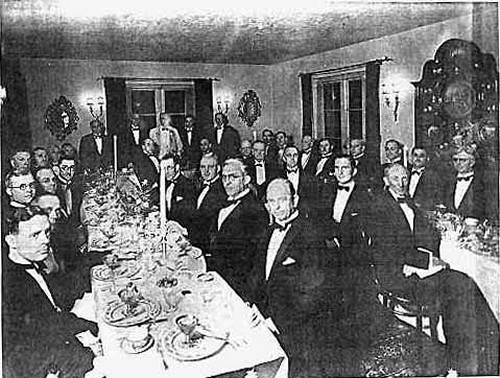
1931 Dinner held to honor Dr. Royal Rife.
If Rife had stopped right there and just stuck to his microscope
invention, he would be a household name today. But he was
stupid. He thought the world might appreciate a cure for
cancer as his encore. What a fool.
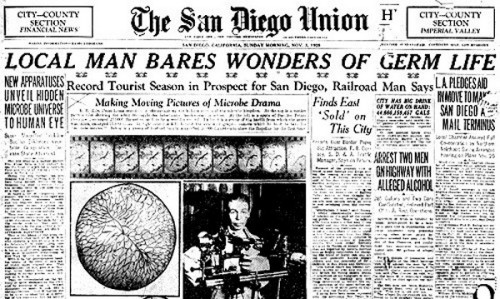
There doesn't seem
to be any doubt that Royal Rife was well respected by the local San
Diego newspaper
|
|
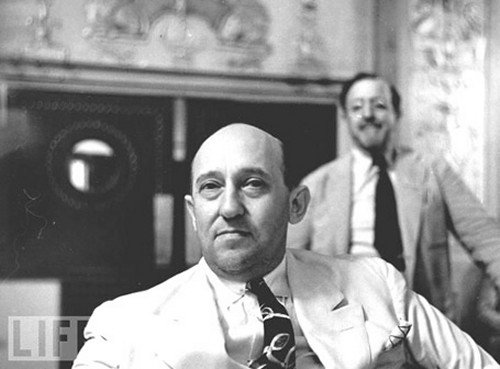 |
Morris
Fishbein
Unfortunately, as if on
cue, it was time for the bad guy to show up. It was Morris Fishbein, the same
man who I wrote about in
Chapter Two.
In
his day, Fishbein took on the entire Dream Team of Alternative
Cancer - Caisse, Gerson, Hoxsey... and Royal Rife.
David Bonello states that
Fishbein
was the legendary hatchet man who ran medicine for nearly 50 years.
Fishbein was rumored to have destroyed many people and many
companies during his reign of terror. Bonello believes the
damage Fishbein did to the health care system of the time deprived untold
numbers of suffering humans any possible chance at a cure. [
source ]
(Rick Archer's
Note: I read an unbelievable account of Morris Fishbein's
career in The Medical Racket, written by Wade Frazier.
He said
Morris Fishbein is responsible for turning cancer
treatment into the racket it is today. He named Fishbein
"the medical gangster of the 20th Century.)
|
|
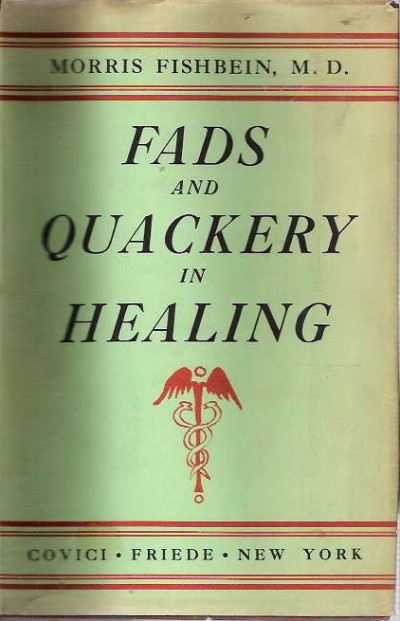 |
In the case of Royal
Rife, the initial contact involved a token attempt to buy out Rife
and his machines. Morris Fishbein was sitting pretty at the
time. He had just acquired the entire stock
of the American Medical Association by 1934. Now he sent an
attorney to Rife with 'an offer you can't refuse.'
Rife refused.
Fishbein probably wasn't
surprised. He must have realized that this strategy would
backfire with Rife. For one thing, Rife paid little attention
to money. It's tough to buy off someone who doesn't care.
Rife mumbled something about this machine being his life work and he
wouldn't dream of selling it.
Ordinary the next step
would be to file some sort of charges to stop Rife's machine.
However, unlike Hoxsey, he could not be arrested for practicing
without a license. (I am not sure what the law says about
zapping people with radio waves).
Nor was Rife shipping
any "treatment" across state line.
For that matter, a trial
on trumped-up charges might backfire. It would mean that testimony
supporting Rife would be introduced by the prominent medical
authorities working with Rife. And the defense would undoubtedly
take the opportunity to introduce evidence such as the 1934 medical
study done in conjunction with USC. One has to realize that
Rife had the support of much of the local medical community.
Furthermore, Rife's own
testimony would surely dazzle the jury. To hear this learned
engineer present decades of accumulated evidence of his work,
including film and stop-motion photographs, plus a scientific
explanation of its efficacy would mean game over. No "expert
witness" on earth could be any match for this humble, sincere genius.
The last thing in the
world the pharmaceutical industry wanted was a public trial about a
painless therapy that cured 100% of the terminal cancer patients and
cost nothing to use but a little electricity. It might give
people the wrong idea that they didn't need the AMA's ineffective cures
any longer.
Nope, the bludgeon of
legal proceedings wouldn't work here. So the powers that be
decided different tactics were needed. How about sabotage and
bribery? Bingo.
|
| |
The Miserable
Takedown of a Decent Man
Rick Archer's Note: I have no way to
determine the truth of the following material. I cannot possibly
vouch for its accuracy. There are two kinds of searches
- superficial and serious. Mine is 'superficial'. I
see no point in thoroughly researching an incident from 80 years
ago. I will simply cut and paste and name my sources.
I will leave it up the reader to decide what to think
about it.
|
According to the article I found at
Altered States, the
problem began with
the gradual pilfering of components, photographs, film, and written
records from Rife's lab. The culprit was never caught.
(Rick Archer's Note: I read
a similar claim in the Max Gerson story. In fact, I found one
strange statement that suggested there was even poison found in
Gerson's
system. You just have to wonder.)
Rife was blind-sided by the loss. These
were the days when photocopies and computers were not
available for use as backups. It had never
occurred to Rife that someone would steal his research documents.
He wasn't even sure what was missing.
While
Rife struggled to reproduce his missing data, one
day he discovered someone had
vandalized his precious virus microscopes. Pieces
of the 5,682 piece Universal microscope were stolen.
Earlier, an arson fire had destroyed the
multi-million dollar Burnett Lab in New Jersey, just as the
scientists there were preparing to announce confirmation of Rife's
work.
Then came a terrible blow.
One day police
illegally confiscated the remainder of Rife's 50 years of research.
However it was a lawsuit
that proved to be the kill shot. That was kind of odd because Rife
won the decision, a "Pyrrhic Victory" of sorts.
In
1939, agents of a family which controlled the
pharmaceutical drug industry assisted
Rife's partner Philip Hoyland in a frivolous lawsuit against his own partners in
the Beam Ray Corporation. This was the only company manufacturing
Rife's frequency instruments.
One
source says that Fishbein himself bribed Hoyland with
$10,000 to file a suit against Rife in order to obtain the company
and include a Fishbein agent on the board of directors while
excluding Rife. Ten grand was quite a lot of money in those days.
Rife counter sued and won in 1939.
However, the
litigation and betrayal took an emotional and financial toll on the
normally reclusive scientist. Rife began drinking.
|
EXCERPTS CONCERNING
THE 1939 TRIAL
(SOURCE)
(Rick
Archer's Note: I will explain who John Hubbard is shortly.
Ben Cullen was the owner of the
Beam Ray Corporation and a close associate of Royal Rife)
Ben
Cullen:
Philip Hoyland was always cunning
when he was working with me. I was turning out all the stuff
and of course was also Executive Vice-President (of Beam
Rays Corporation) for quite a while, and Philip had some
sneaky ways about him.
The
Khan Realty Company brothers came down here from Los Angeles
at the behest of the head of the AMA - his name was Morris
Fishbein. So they came to
see if they could find out something about us at the direct
request of the head of the AMA.
They found quite a good deal with Dr. James B. Couche,
who was a very fine physician and surgeon and had been a
Fellow of the College of Surgeons for twenty years... and
Philip was in the office with us, and when they had found
what we were doing they said, "Well we would like to buy
into this corporation."
"Well,"
I said, "This happens to be a closed corporation, we haven't
requested the Commissioner of Corporations for the privilege
to issue stock. That would take a long time if we did. At
the present time we are not in a position to actually do
that."
So one of the brothers
acted a little bit belligerent, and he said, "Well you ought
to do something about it." And I said, "Why?"
And he said "It would be
good for you, it might be healthy for you."
So I thought, "That is
strange." And so they left finally.
John Hubbard: These two
brothers?
Ben Cullen: These two
bothers of the Khan Realty Company.
John Hubbard: The Khan
Realty Company was in Los Angeles?
Ben Cullen: Yes, Los
Angeles. They were a German Jewish Realty Company, their
name was German-Jewish. And they met Philip Hoyland. I
noticed that Philip was showing considerable appearance of
friendliness toward them and I didn't think much about it
until later I had found out that they had gotten hold of him
and bribed him with a $10,000 check.
John Hubbard: Did you
ever see the check? How did you find out about the $10,000
check.
Ben
Cullen:
I didn't
see the check but I do know this... that it came from many
sources and from his own lips later that they paid him
$10,000 and he had wished to God that he hadn't ever
accepted it. But just like Judas Iscariot who betrayed
Jesus, as soon as he got that $10,000 check,
then he kicked us into the courts on... not on bankruptcy
but something similar to that.
John Hubbard: He wanted to
get the directors changed.
Ben
Cullen:
Yes, he
wanted to get the whole thing changed. But what happened was
this Aaron Sapiro came out from Chicago, the Prosecuting
Attorney - paid by the AMA.
John Hubbard: How do you
know that Sapiro was paid by the AMA?
Ben
Cullen:
Because he made that statement to Bert Comparet and to
others, and of course I was often times in the group and I
heard what was said.
............
EXCERPTS CONCERNING
THE EFFECTIVENESS OF THE TREATMENT
John Hubbard:
What about
Milbank Johnson? Do you remember Milbank Johnson very well?
Ben
Cullen:
Yes, he was a
big, tall, handsome gentleman - very, very knowledgeable and
extremely interested in Rife. He wrote a very fine letter
one time after he had seen the work that was done at Miss
Helen Scripps home on the treatment of a boy with papilloma.
Around the neck here a cancer had eaten through so you could
see the sinews and see the neck bones, so much of the flesh
had dropped off around here. The boy had to be held up on
this side all the time and held down so he could move his
neck. Now Milbank Johnson, and Kendall, and Rosenow were
there at the time that this work was done and they saw the
tremendous value of the Rife Ray instrument because it
actually cured that boy's papilloma up to a point where he
had some scar tissue for some time but he definitely was
saved. He did not die. He was healthy and able to go back to
work. Then there was that breast cancer incident.
Ben
Cullen:
Benjamin
Henderson brought his wife to Dr. James Couche to treat.
She had one of the worst cases of breast carcinoma I have
ever seen. In fact her breast was almost all sloughed off.
It looked terrible. But Dr. Couche, with the original
laboratory instrument, cleared it up.
John Hubbard:
The original
laboratory instrument? The one Rife himself had built?
Ben
Cullen:
Yes.
................
|
Although Philip Hoyland
lost the trial, his assisted legal assault had
the desired effect: the company was bankrupted by
the legal expenses mounting a defense. During the
Great Depression, this meant that all commercial production of Rife's
frequency instruments ceased completely.
The harassment
continued. The few doctors
who had tried to defend Rife lost their foundation grants and hospital
privileges.
Huge amounts of money were
spent ensuring that doctors who had seen Rife's therapy would forget
what they saw. Almost no price was
too much to suppress this damn microscope if it
meant protecting the precious cancer money train.
The cruelest blow of all came when Arthur
Kendall, the Director of the Northwestern School of Medicine,
turned against him. Kendall had worked
closely with Rife on the cancer virus.
It is said he accepted
almost a quarter of a million dollars to suddenly 'retire' in
Mexico. That was an exorbitant amount of money in the Depression
era.
Kendall wasn't alone.
Dr. George Dock, another
prominent figure who collaborated with Rife, was silenced with an
enormous grant, along with the highest honors the AMA could bestow.
Between the carrots and the sticks, everyone except Dr.
James Couche and
Dr. Milbank Johnson gave up Rife's work and went back to prescribing
drugs.
Rife had a small support
system left. A small circle of doctors in California
continued to stand by Rife despite the national pressure.
This circle had the protection of Dr.
Milbank Johnson,
a politically powerful medical person. This
was the same Dr. Milbank Johnson
who had thrown that 1931 dinner. He was always in Rife's corner.
However, Dr. Johnson suddenly passed away in
1944.
Suspiciously, upon Dr. Johnson's death, many of the documents
Johnson had held from
the USC clinical trails completely disappeared. Not long
after that, investigators
began to suspect that Johnson
had been poisoned.
Seeing that Johnson was just about to
begin announcing Rife's successes publicly
to the national media, the timing was very curious.
source
The loss of the
influential Dr. Johnson put the final nail in the coffin for Rife's
career. The moment Johnson died in 1944, Royal Rife seemed to
disappear from existence.
|

If you look
carefully, you will spot the name of Arthur Kendall in this article. Kendall accepted the Judas role
just like Philip Hoyland did. They sold Rife out.
|
Hiding the Truth
Now came the final
stages of the cover-up. To finish the job, the medical journals
refused to publish any paper by anyone on Rife's therapy.
Supported almost entirely by drug
company revenues and controlled by the AMA, these
journals weren't going to bite the hand that fed them.
Apparently in the medical profession, if
you don't publish, you cease to exist. Therefore, an entire
generation of medical students graduated into practice without ever
once hearing of Rife's breakthroughs in medicine.
Rife was a brilliant
inventor, not a brass-tacks street fighter. In fact, when it came to
confrontation, Rife ran for the hills. Every time something
went wrong, Rife retreated further into a shell. Ever since
the glory days of the 1934 USC clinical trial, his life had turned
to hell and his
career had been ruined. The inevitable conclusion
reached by Rife was that his life-long work had
gone down the drain. He assumed his discoveries
would probably be buried with him.
The Forties were a
barren time for him. At that point, Rife ceased to produce much of
anything. He spent the last third of his life seeking oblivion in
alcohol. It dulled the pain of
the acute
awareness that his half
century of brilliant work had gone down
the drain. His efforts had been cast
aside. Meanwhile, with the Rife inventions neutralized, the unnecessary suffering of millions
continued so that a vested few might profit.
And
profit they did, and profit they do.
A Peek into the Personality of
a Genius
(SOURCE)
John Hubbard:
I
have known about this microscope since 1947. I found this report in
the Smithsonian Institute report and I wrote to Rife back in 1949
but he never answered me. I kept asking and sending letters and so
forth...
Ben
Cullen:
At
that time (1949), that was just exactly ten years from the time he
started drinking during that trial. He was mentally pretty
well in shock after that. I couldn't get him to do hardly anything.
I tried to get him to provide us with closed-circuit television in
Lion Aeronautical. I tried to get him to provide us with information
and help in our laboratories over at Convair in regard to metallic
crystallography and stuff of that sort. And he could have made a lot
of money that way. But every time I got him closeted with a group of
engineers and he would start to outline his thoughts and what he
could do and they were all sitting on tender hooks - he would excuse
himself and go outside.
By the time he got back he would be waddling. He had to have that
liquor - which of course was the fault of the advice and council he
received in 1939 during the final windup of our case where we were
accused by the AMA of doing something they did not like in regard to
the application of the Rife ray for cancer and so forth. And of
course that was all a mistake. Of course they had the right kind of
help, medical men of repute. But by that time when Rife came on the
stage and on the witness stand to testify, he went all to pieces.
John Hubbard:
And
this was in 1939?
Ben
Cullen:
Yes.
John Hubbard:
Now,
I went down to the courthouse and copied all of the records on that
trial and I read them on the projection machine, they have them on
microfilm down there, and I was just surprised. There would be times
when they would want Rife to come to court and from the record there
- he wouldn't show up.
Ben
Cullen:
No,
he wouldn't.
John Hubbard:
Was
that because he would be drunk, or what?
Ben
Cullen:
No,
it wasn't that. Rife was a tremendously capable man as long as he
could manipulate what he was working with. When it came to being in
a court of law, where you're right down to dog-eat-dog, why, that
just unnerved him and he couldn't stand it.
John Hubbard:
What
kind of questions would they ask him that would unnerve him?
Ben
Cullen:
It
wasn't that any questions would be asked to unnerve him - but here
he was a man who had spent his lifetime in doing things that others
had told him were wonderful - just simply marvelous - his lenses and
stethoscope, so many, many things that he did. All this he was told
by many men from England and from Germany and other places that he
was an excellent man in his field.
Possibly I am not
using the correct nomenclature and verbiage that I should use, but
nevertheless, he absolutely felt on top. And when he got into court
he became a simple, plain human being. And anything he might say he
was afraid might incriminate him - although there was nothing at all
that the trial could find that he would be at any time considered
culpable in any mistake at all or anything that might have been
done. It was all done of course through our corporation: The Beam
Rays Corporation.
Now, Rife felt completely frustrated because he could not do
anything in court except say "yes" or "no" - and he knew what to say
and he was not allowed to say it. If he was allowed to enlarge the
least little bit, why, the Prosecution would cut him right off and
there would be a fight as to whether it should be entered in the
record or stricken from the record or what. It so unnerved him that
he was just simply scared to death. He was not at all conversant
with law. The only law he knew was the law of research and
investigation
..............
John Hubbard:
Was
Rife very religious?
Ben
Cullen:
Not
too much, no. He was very psychic. He could draw from the ocean of
mind - which I call it, another side - information about many things
he couldn't have in his conscious state. As I told you, when he
wanted an answer he would put his pad and pencil by his bedside and
between 11 and 2 o'clock he always got his answer.
Rick Archer's
Note:
That unusual comment reminds me of Edgar Cayce, the Sleeping
Prophet. Cayce, an uneducated man, could put himself into
a trance and come up with medical solutions that far transcended
the understanding of not only himself in a waking state, but
medical authorities as well. To everyone's amazement,
Cayce's bizarre treatment suggestions would always work
perfectly. The story of Edgar Cayce is the perfect example
that there is a lot about medicine we don't know.
EDGAR CAYCE ON CANCER
|
The Forties
Throughout the 1940s, little was heard concerning Royal Rife.
The Beam
Ray Corporation was gone now. It had gone bankrupt following the costly 1939 lawsuit.
According to Ben Cullen, Rife's friend and former business partner,
Rife spent the Forties drinking and feeling sorry for himself.
The loss of his career had left him devastated. His work had
given him his reason to exist. Without it, he was lost.
But Rife assumed that any attempt to return to his earlier work
would end in more persecution from Morris Fishbein. Rife felt
helpless to fight back. So he just wandered around in shock.
In 1942, Dr. Raymond
Seidel decided to write a piece about Rife. One of few pieces of
correspondence from that era to surface was a June 1942 letter from Dr. Raymond
Seidel to Rife with questions about the Universal Microscope for an
article Seidel was preparing for the Franklin Institute (and later
the Smithsonian as well). Many years later, this particular article would serve a
special role.
In 1949, Morris Fishbein was
forced to step down from the AMA after losing his libel fight with
Harry Hoxsey.
The
Comeback
In 1950, with his
nemesis Fishbein out of the way, perhaps this emboldened Rife to try
again. His first step was to hire John
Crane as a machinist. Crane was an engineer who had become aware of Rife’s story
and approached him. Crane proposed to collaborate with him in producing
his frequency device again. For the next decade, Crane devoted his
life to doing just that.
During Rife's decade of
feeling sorry for himself, he had at least spent some time thinking
of ways to improve his Frequency Machine. He offered his suggestions
to Crane, then took a backseat. Crane was a good man and
had a lot of energy. Corresponding
with medical authorities and hiring experts to further develop
the Rife frequency device, Crane made some major breakthroughs,
making the device even more effective than it was in the 1930s. Then
Crane put his heart into producing new machines and selling them.
In 1957, Rife's wife of
45 years
died. Mamie had been the rock that had held him together all these
years of torment. Now she was gone. Rife had always been on the fragile side.
It was the protective umbrella formed by his wife and his friend Dr.
Johnson that had largely shielded Rife from the firestorm surrounding his
work. Now that he was alone, Rife fell to pieces. He simply couldn't take the fear
and the stress any more. He wasn't in very good health either.
He was nearly 70 now and his eyesight was failing. The various trials and medical witch-hunts took a terrible toll on
both his health and his mental state.
In 1958, the FDA began
harassing John Crane. He watched in stunned disbelief as the
State Department of Public Health held a hearing in 1958 to
determine if the Frequency Instrument should be approved as a
treatment device. Sure enough, they outlawed it. Rife
quickly fell to pieces. Crane was bitter as well, but he
continued to soldier on despite the interference.
In 1960, Crane was
making and selling the device, along with a detailed technical
manual on how to use it, and was attempting to get it patented when
all hell broke loose. The FDA picked up right where Fishbein
had left off. Medical authorities raided Crane's facility in
California and seized everything: machines, engineering data,
research records and reports, pictures off the walls, etc.
They did not even have a search warrant. Then the railroad
treatment began, with the kangaroo court tactics to follow.
Rife was terrified.
The 1939 lawsuit had led directly to drinking and a nervous
breakdown. Rife had no courage left. In 1961, Royal Rife
fled the country for Mexico to avoid this new series of FDA legal
harassment. Crane was left behind to take all the heat.
While Rife cowered in
some Mexican cantina drinking himself to death, they sent Crane to
jail on trumped up charges. [
source
]
Oblivion
Little is known of what
happened to Rife during his final years.
Although Rife remained an expatriate for much of the final ten years
of his life, there were rumors that Rife did return to San Diego from
time to time whenever the coast was clear.
Reports say he spent much of
his time drinking heavily.
In 1971, the last year
of his life, Royal Rife couldn't care for himself any longer.
He moved himself into a rest home in El Cajon,
a little town in the hills east of San Diego. According to the
local newspaper, he died alone and penniless.
The autopsy pointed to a
combination of valium and alcohol as the cause.
The headline of his final press clipping really said it all.
|
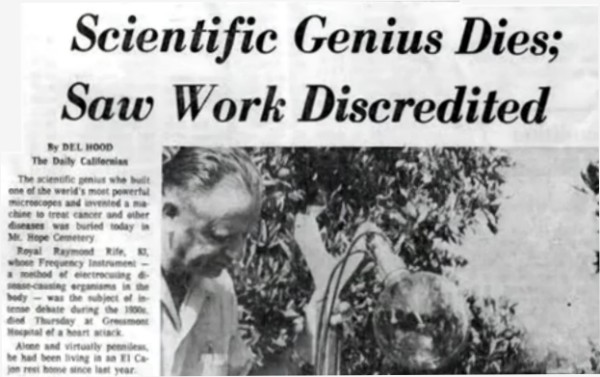 |
|
| |
The John
Crane Trial
John Crane's personal account
told to Barry Lynes,
author of The Cancer Cure That Worked
[
source ]
John Crane was a close
associate to Royal Rife. Rife trusted Crane and made him his
heir.
By 1960, Crane had written and copyrighted a manual which explained
how the Frequency Instrument was to be used in the experimental
treatment of various diseases and on different parts of the body. By
that year, 90 instruments were distributed for research and
verification on notarized contracts.
And then the medical authorities struck.
They raided Crane's office, took over $40,000 in machines, frequency
instruments, and one large Rife ray tube instrument, along with
engineering data, research records and reports, pictures off the
wall, private letters, invoices, tape recordings, and electronic
parts.
They had no
search warrant.
They smashed all the research which had been put together over 10
laborious years. As in 1939, they visited the doctors who were
experimenting with the machines and forced them to abandon them.
They also pressured ordinary citizens who
had begun experimenting on a personal basis.
These visits were made by teams of
overzealous investigators.
"One woman was scared so bad that she
has been in a sanitarium driven entirely out of her mind. Her
husband cursed them out and told them to get off his property.
He has threatened to exterminate them should they return.
His wife has undergone shock treatments and two months of
hospitalization."
Then the FDA took Crane
to court. He was criminally indicted and tried on charges
involving practicing medicine without a license.
The records and materials
previously seized were not allowed to be
used by Crane in his own defense during his trial.
Roy Rife, almost 73 and incapable of suffering the abuse of another
trial at his age, went into hiding in Mexico. His deposition was not
permitted to be introduced at the trial. Neither were the medical
and scientific reports from the 1930s and 1940s. Nor were medical
reports from Dr. Stafford in Ohio. Dr. Couche's letters were also
declared inadmissible. No medical or scientific report which
indicated the Frequency Instrument worked as represented was
permitted to be introduced at the trial.
Crane was left with only the patients who
had been cured or helped to stick up for him.
The trial was held in early 1961. After 24 days, and despite the
testimony of 14 patients who told how the Frequency Instrument cured
ailments and diseases which orthodox medicine could not alleviate,
Crane was found guilty.
The only medical opinion offered by the
State of California came from Dr. Paul Shea who had been given a
Frequency Instrument by the Public Health Department for 2 months
before the trial. Shea admitted he never tried the Frequency
Instrument on anything or made any tests to evaluate it. He simply
examined it and decided that it had no curative powers and didn't
lend itself to investigative use.
Also, and most disturbing, the foreman of
the jury was an AMA doctor. Everyone else was carefully screened to
see that they had no medical knowledge, no electronic knowledge, and
didn't read any newspapers supporting alternative healing.
The verdict was a foregone conclusion.
Crane was sentenced to 10 years in jail. Following appeals, two
of the three counts against Crane were reversed in the California
Supreme Court because no specific criminal intent had been proven.
Crane would spend
3 years and 1 month in jail.
After Crane was imprisoned, so much
pressure was put on Dr. Stafford in Ohio that he gave up medicine
and became a salesman. Another doctor in Salt Lake City had his
Frequency Instrument sabotaged and then was hounded by the orthodox
medical authorities to such an extent that he committed suicide.
Such were the lengths to which the
anti-Rife forces were willing to go in order to prevent the testing
and use of this breakthrough technology. Rife's
cure for cancer had been effectively suppressed again.
|
 |
| |
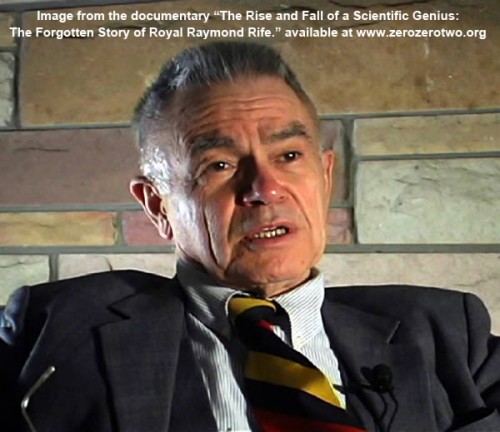 |
But
Wait! There's More!
John
Hubbard, MD, was a practicing
pathologist and Associate
Professor of Pathology
at the State University of New
York at Buffalo. He passed away in
2004.
Requiem for Royal Rife
The John Hubbard
Interviews: Introduction
By Shawn Montgomery
Rick
Archer's Note: Shawn Montgomery is a dedicated
Royal Rife researcher. He spent much of the
Nineties tracking down every piece of information Rife
possible. His interest in Rife led him to meet
with John Hubbard, one of the pioneers of the unusual
field of 'Rife Research'. Montgomery's work led to
a much-praised Rife documentary.
I have paraphrased some of Mr. Montgomery's story about
his search for the truth. You may read the story in its
original form
here.
|
The Preposterous Legend
Have you ever heard
a story crazier than this?
An eccentric genius in
depression-era California invents
several fantastic medical devices including super
microscopes and a death ray for microbes. In a
twenty-year research initiative costing millions of
dollars and backed by the most prestigious men in
medical science, this genius endeavors
to deliver the "cure for cancer" to the world.
After years
of painstaking effort, he
perfects the ultimate microscope. This allows him
to peer into a world no one else can see. Now he
discovers a virus in
cancer tumors. Armed with this
valuable clue, the man
develops a way to destroy that
virus with a beam of electrical energy produced by his
newest invention: the Beam Ray
Machine.
As word of
his work spreads, human clinical trials
are set up and presided over
by top-of-their-field doctors who were
anxious to
put this machine to a test. They are both shocked
and delighted to discover that the "cure" was one
hundred percent effective. 16
so-called terminal patients enjoy full
recoveries.
Suddenly,
out of nowhere, the AMA steps
in. Using nefarious
means, they shut down the
whole endeavor. The cure for cancer is
denied to the world because it is
not pharmaceutically based and therefore not profitable
to drug companies.
Tormented,
harassed at every turn, and grief-stricken that his
life's work has been destroyed, the genius flees to
Mexico to escape further persecution. Now he
becomes a recluse and proceeds to drink himself to
death. All of his countless thousands of hours of
research spread over years and years had all gone for
naught. He had invented a machine for the ages.
By all that is right, he should have gone down as the
most famous inventor in history. Considering the
importance of his work, people would quite possibly
refer to him a savior of mankind.... but that was
impossible now.
No one would
ever know he existed or accomplished because his story
has been totally erased. He dies a lonely pauper
in an obscure Mexican village.
This ridiculous
story actually floated around as rumor for several
decades following World War Two, but no
one took it seriously. After
all, it reads like an
unlikely plot to a
low budget sci fi flick.
It isn't terribly realistic.
After all, how does someone erase the story of a machine
that can save mankind?
Lacking any corroborative evidence,
telling details, or historical presence,
there was little reason to believe it was true.
A tad too apocryphal. Surely allegorical.
Someone invented a machine that cured
cancer and it disappeared? How in a modern world could
that ever happen? Even more important, why would
someone destroy a machine that could save mankind?
Given the lack
of any apparent record, this
far-fetched tale was easily
dismissed as someone's idea of a joke.
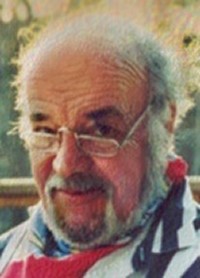 |
Christopher
Bird
In the early 1970's, journalist Christopher
Bird heard this rumor himself.
Curious, he did some digging. He had heard
this story several times and each
time was equal part disturbed and fascinated.
He wanted to settle its veracity once and for
all. To his
surprise, it
didn't take long for him to find
a possible source for at least part of the
rumor.
Bird came upon a stunning
article. The same article
was printed in two
different 1944 science journals: The
Journal of the Smithsonian Institute and
The Journal of the
Franklin Institute.
R.E. Seidel, M.D;
M. Elizabeth Winter (1944). "The New
Microscopes".
Annual Report of the Board of Regents
of the Smithsonian Institution
(Smithsonian Institution).
|
Bird
felt his heart race as he read the material.
The article,
titled "The New Microscopes",
gave a detailed account of the work of the eccentric
genius in the crazy story. Bird
was incredulous at his discovery. This was
almost like finding the Holy Grail really does
exist. This was a story that had to be told.
Working from there, journalist Bird
kept digging. More and more nuggets
surfaced. Bird was able to determine that the
crazy story wasn't just true, it was
completely true! Bird
published his discovery in the
New Age Journal.
His
article was titled "What Has
Become of the Rife Microscope?"
(click
here to read Bird's original article. It
offers up a treasure trove of important details.)
It had taken thirty years for the sad and deeply buried saga
of Royal Raymond Rife to finally resurface.
What a shame it was that Royal Rife
would not benefit from the recognition. He had died
just a couple years earlier in 1971.
How could a
story of this magnitude get buried?
Those of course were the days before
computer technology. Unless you had some sort of hard
evidence like a name or a place or a witness, tracking down
a rumor was hit or miss.
Today it is a simple matter to do an internet search on
"Royal Raymond Rife" and have delivered to your computer a
wealth of information on history's most
famous "forgotten scientist".
You'll find not just the "New
Microscopes" article from the Smithsonian Journal and
Bird's article in the New Age
Journal on the Internet, but
so much more. Today there is
a wealth of corroborative data: dozens of newspaper and
science journal articles, hundreds of personal letters
between the doctors involved, photographs of
Rife himself, Rife's scopes and
his other inventions, schematics,
lab notes, lab films, reports, interviews, books, and
documentaries.
Thanks in large part to Christopher Bird,
Rife's long-forgotten
achievements have come back to
life. The remarkable story of Rife is a rumor no
more.
However, there is a dark footnote.
One would assume releasing a
suppressed science from its veil
of obscurity would be a glorious thing, especially a
potential cure for cancer. However,
in the case of Rife, the glory is somewhat diminished
by the disappearance of his device.
This changes the story
dramatically. Now we have the tale of a cure for
cancer that is gone forever.
Though many details of his contributions survive as
documentary evidence: pictures, films, schematics,
testimony, reports and so forth - the real treasure would be
finding operational Rife Microscopes, Beam Ray Machines, or
other artifacts.
Today
the location and condition of many of Rife's inventions
remains largely uncertain. Thirty years ago it was not much
different even though the trail was much warmer. The
documents that attest to the reality of these things
are in hand, so where
are these
machines now?
John
Hubbard
It was in the mid-1940's that a young student of pathology
named John Hubbard first became
obsessed with the Rife Universal Microscope.
Hubbard
was doing his best to keep up with current
advancements in the tools of his chosen field.
He was thumbing through the above-mentioned
Journal of the Smithsonian Institute when he came upon
the article titled "The New Microscopes".
In astonishment,
Hubbard read about Rife's instrument - a microscope
that appeared to defy the accepted limits of optics.
Taken at face value, the text of the article seemed somewhat
incredible. However, three photomicrographs included
therein, taken through the Universal Microscope, tempered
Hubbard's incredulity. The published photos were all labeled
with magnification values: Chlorophyll (Cell) 17,000X;
Tetanus (Spore) 25,000X Typhoid Bacillus (B. Typhosus)
23,000X. Hubbard recognized the extraordinary features of
the pictures: the uncanny resolution of detail; the
fantastic magnification values (one order higher than
standard optical scopes); the clear imaging of certain
structural features within the specimens (the existence of
which had previously only been suspected by microbiologists
- never seen and confirmed).
Here it was: the ultimate microscope. This was a tool that
could crack open the still-murky world of germs and spill
all of the remaining secrets out onto the table. This was a
tool that could help to answer just about any question a
microbiologist could ask. Hubbard was duly impressed. In his
mind, the near-anomalous-looking photos confirmed the story.
This was one microscope he wanted to have. Reading about it
was one thing, but actually working with such a scope in
one's lab would elevate any microbiologist onto a whole new
level. As a student of pathology, he
practically drooled at the value of such an asset to his
profession.
So Hubbard began
searching in earnest.
Mind you, the trail should have
been warm. Rife had gone off the radar in 1939.
It was now 1947. He sent letters to everyone he
could think of: the Royal Rife in the article of course, its
authors, and any other names or places mentioned in the
text. He sent letters to all optical companies: Leitz, Zeiss,
American Optical etc... asking if they had any info on this
microscope. Unfortunately, it was a fruitless effort.
The war had just ended and people were
preoccupied with putting their post-war lives together.
Most of Hubbard's
correspondence went unanswered. Nobody
seemed to know anything about it or those that did weren't
talking.
Hubbard was
deeply frustrated that both the microscope and its
inventor had remained
so elusive.
However,
he had just graduated and the demands
of his new career took precedent. Hubbard reluctantly
gave up the search and moved on.
Thirty Years Later
Fast forward
thirty years. Now the
inquisitive young student had matured into a tenured
Professor of Pathology at New York University in Buffalo.
One day in the mid-1970's,
Professor Hubbard serendipitously regained the scent
of his long lost trail.
By chance, Hubbard happened upon
Christopher Bird's article while browsing a magazine rack.
Hubbard's fascination with Rife and his super-microscopes
was instantly reawakened. Hubbard
shuddered as a fever told hold of him. Bird's article
had set him on fire.
The mystery that
had once obsessed him and defeated him was back. Maybe
it wasn't too late to find that microscope!
Armed with this new information,
Professor Hubbard immediately
contacted Christopher Bird. Not
surprisingly, Bird was still very
much immersed in his own quest for Rife artifacts.
He had received valuable new leads from people who had
noticed his article.
The first
meeting between Bird and Hubbard went well. As they
spoke, Bird could not believe his luck. Bird
had been looking for an expert in
microscopy and pathology to help him with
a new problem. His fear was giving the secret to the
wrong person.
The rapport he
felt with Hubbard led him to take a chance.
Bird lowered
his voice to a whisper. He confided in Hubbard that he
had just located the estate
of the recently deceased Royal
Rife. Furthermore, Bird was
in contact with a certain John F.
Crane. Crane was a
mechanical engineer from San Diego who
had been named Rife's heir.
Bird had just
received permission to come take a look at certain machines
in Crane's possession. Bird could barely contain his
excitement at the chance of discovering one of these
precious microscopes, but how would he ever know whether it
was any good or not? Bird looked at Hubbard. Did
Hubbard know enough to assess
the instruments that Crane said
were in his possession.
Hubbard nodded
yes. Now both men were equally excited.
Their quests merged. Soon
Hubbard and Bird were working together in an investigative
capacity, determined to unearth, examine, and if possible
obtain a Rife Microscope and a Beam Ray Machine.
Plus they both wanted to uncover the rest of the
story on this crazy Rife saga. They
both had a huge list of unanswered questions.
They didn't know it at the time,
but John Hubbard and Christopher
Bird had just become the first
Rife Researchers. The trail
Hubbard and Bird would uncover pointed
the way for investigations that would
involve thousands of people
in the decades
to come. They were the
pioneers of what would become the labyrinthine
field of "Modern Rife Research".
The
Quest
As they headed
to their meeting with John Crane, their mission
was to reestablish the technology, methodology, and
discipline that led Rife to his recorded successes.
Unfortunately
their hopes of finding an intact Rife device were
immediately dashed. When
Hubbard arrived at John Crane's house in San Diego,
he finally set eyes on the precious scientific
treasure that he had been dreaming of for decades.
Hubbard's heart sank. He found the machines to
be in "near ruins," surrounded by "disarray and clutter".
Hubbard then made eye
contact with a "disheveled and unhealthy-looking" Crane.
Crane had just turned pale. Hubbard guessed that Crane
had just become oddly unaware of his glaring
ineptness as a guardian. Crane
realized what the fallen faces of his visitors meant.
Despite the value and importance of the artifacts
that cluttered his place, Crane had made
no effort to take even the basic steps to protect them.
Hubbard would
later comment that John
Crane was "the most terrifically awful curator of scientific
instruments imaginable".
Hubbard would
come to realize that John Crane was the owner of the
lion's share of Rife's surviving "stuff".
There were no other sources to find other machines.
Ultimately, Hubbard's quest turned into a long,
protracted negotiation with John Crane to get him to release
the microscopes over to the University of New York for study
on purely academic grounds. In
addition, he simultaneously tried
to recruit the services of a group of men who had
actually worked with Rife on the same microscopes.
Perhaps the keen minds of his school's engineers and this
reconstructionist team could
somehow reverse engineer a new working machine. Hubbard
spared no effort trying to
bring the intricate instruments back into working order.
[
Rick Archer's Note: I
found no mention in the article of the results of Hubbard's
reconstruction project ]
Meanwhile Bird
and Hubbard obtained from
Crane a list of about a dozen names with some contact
information. These were
people who were still alive that knew or worked with Rife.
They went to San Diego, Chicago, England, and Los Angeles,
anywhere that the information led. This
began an interview process that lasted years,
predominantly conducted by Professor Hubbard, and thankfully
one which he recorded. This
process ended around 1977.
Rife
Comes Back to Life
Twenty years
later, Shawn Montgomery, the writer of this story, met Professor Hubbard
for the first time. It was now 1996. A few
years prior Montgomery had become one of those so-called "Rife
Researchers." Montgomery had seen Hubbard's
name crop up from time to time among the pages of a rather
voluminous pile of his own accumulated "Rife documents".
With the help of his friend and fellow Rife
Researcher, Jason Ringas, the pair had compiled
quite a stack which cost many years and
many dollars.
Ringas and Montgomery traveled to Buffalo
to meet with Professor Hubbard to talk
shop and share information and documents.
Montgomery learned the most notable
item in his data collection were
Hubbard's forty hours of recorded
audio interviews with various people who
had known and worked
with Rife. Hubbard allowed
the pair to make copies of the
twenty-year-old recordings.
Montgomery took the copies home with
him
and transcribed them.
Ten years later it was now 2006.
Everyone that was involved in that early
research/resurrection effort was dead. John Hubbard died
in 2004. Chris Bird died
in 1996. John Crane died in
1995. Rife of course died before all these
three people
had even met.
Everyone interviewed by Hubbard and Bird were already old
men thirty years ago when the interviews took place
and most of them were gone as well.
Consequently Montgomery could tell
he was the strongest link left standing to this incredible
tale.
So Montgomery
began work on a film detailing the strange career of Royal
Rife.
Much of Montgomery's work is hosted on
the
website
of Jeff Rense. Here one can
go to hear these Rife associates speak again.
Rick Archer's Note: Shawn
Montgomery made a film based on his
research. Here is the description:
The Rise and Fall of a Scientific
Genius: The Forgotten Story of
Royal Raymond Rife
See the staggering discoveries and work
of Roy Rife which led him to a cure for
cancer (among many other diseases) in
1934.
Hear Rife's own voice describe his
breakthroughs and successes which shook
the medical-pharmaceutical establishment
to its core.
This all new, completely re-edited DVD
version of the original two-part film by
Shawn Montgomery, will leave you reeling
with anger and shock at what has been
withheld from all of us by men with an
unbridled lust for profits and a
complete disregard for the welfare of
humanity.
"The Rise and Fall" shows how Rife's own
brilliance led him to eventual ruin in
the hands of the hopelessly corrupt
American Medical Association, which did
not and still does not want you to know
his astonishing story. Countless
millions of lives have been lost due to
conflicting interests within the
so-called Cancer Industry.
You can get more
information
here
For interviews with people who knew
Royal Rife, take a look at John
Hubbard's interviews,
Part One and
Part Two
|
|
Robert Page, a personal friend of Royal Rife
(in a letter to John
Hubbard)
"John, Royal Raymond Rife was expert in several fields and ahead
of the pack in some of them; and this can never be taken away from
him. He deserves to go down in the pages of history as one of the
great, or at least one of the near great minds of our century. But
he will not get this reward because of a personality fault or
several of those.
1)
I've often had the feeling that he divided all humanity in two
groups: those he could trust implicitly, and those to never be
trusted.
2)
He had nearly complete contempt for the mental abilities of 99.9% of
the members of the medical profession (and particularly if they were
as you are involved in the teaching of medical students. (I
think this particular attached to the schools more than to faculty
members as individuals). He often expressed complete and utter
contempt for research faculty types. They would visit his laboratory
but could repeat his work only if he stood behind them telling them
how and when to take each new step. His contempt for some highly
renowned scientists was, I had thought, so widely known that men of
small stature would be out to shoot him down.
3)
He never checked up on people he should and shouldn't trust.
4)
He was never emotionally prepared for any reversals, because he
never expected any and couldn't really accept them when they came.
He was a genius, but he was also very fragile.
5)
His basic philosophy in life was to help people (through his giant
intellect given him for this reason), and when "people" were ready
to jail him for his acts (good or bad legal or illegal), he fell
apart.
|
|
|
|
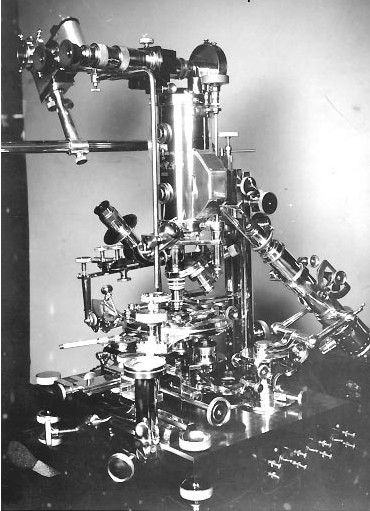 |
Rick
Archer's Take on Royal Rife
During my
Internet wanderings, every now and then I come across a
statement like this:
I know for an
absolute stone cold fact that at least a dozen very effective
cancer treatments have been suppressed by mainstream medicine in
the last 70 some years. See my research into some of these
treatments and the books referenced on my site for the enormous
amount of evidence supporting my conclusions.
- Gavin Phillips [
source ]
I myself am not
quite so confident. I don't know for a "stone
cold fact" of any
cancer cure that works. However, if I had to put money on one
cure, I
would start with this incredible microscope and the other
Rife inventions. The explanations
of his inventions are so profoundly well documented that
there is not a shred of doubt in my mind that his machines
worked just the way Rife claimed they did.
Do I believe
Rife's inventions could cure cancer? Yes. I was very
impressed by the 1934 USC clinical trial that cured 16
terminally ill cancer patients took place. An
amazing story.
I
found the story of Royal Rife and the loss of his
inventions to be deeply disturbing. Why would anyone
in their right mind feel it was okay to sabotage the life
work of this obvious genius? This brings up a very
dark question. Are there people who are actively
committed to evil? If one believes in free will, then
this distinct possibility is not easily dismissed.
|

For just a moment, a
very precocious student in college, a young man with a dazzling
array of different talents, allows himself to daydream. His
heroes are great scientists like DaVinci and Pasteur. His
contemporaries are Edison and Einstein. Where will his amazing
collection of talents lead him? Will he someday make a
contribution that men of this caliber would respect him for?
Twenty years pass.
Imagine, for a moment,
that this same man has spent the past two decades in painfully
laborious research. He has invented the ultimate microscope.
This has allowed him to understand the very nature of disease.
In a brilliant flash of insight, he thinks of a way to kill these
harmful viruses without hurting healthy tissue, then has the genius
to design the Beam Ray Frequency Machine that can carry out his
vision. This man has discovered an incredibly simple,
electronic approach to curing literally every disease on the planet
caused by viruses and bacteria.
Indeed, it is a
discovery that potentially could end the pain and suffering of the
human race and change life on Earth forever.
Now, in a quiet isolated
corner of his laboratory, this man wonders if he is on the brink of
universal celebrity and the appreciation of the entire human race
for his contribution. Humble man that he is, he probably
doesn't even realize just how rich he will be as well. That
was never his goal. All he ever wanted to do was to use his
God-given talents to make a valuable contribution to science.
Royal Rife was a medical genius who was quite arguably the equal of
the most brilliant scientists of all time.
Can you even begin to
imagine that a man who was quite possibly the intellectual equal to
any single giant in scientific history actually had his amazing
inventions totally erased?
Let's play a game.
Try to imagine a world
without Einstein... or Edison... or Davinci... or
Pasteur.
Without Einstein, our
entire understanding of physics would be gone. Without Edison,
we would still be in the dark. Speaking of the dark, without
DaVinci, there would be no Scientific Revolution in the Dark Ages.
And without Pasteur, we still wouldn't know the origins of disease.
And what would our world
be like without Royal Rife?
We would live in a world
where countless millions of people die an excruciating, painful
death from cancer every year. We would live in a world where
one in two people can expect to contract cancer in their lifetime.
We would live in a world where the people who wish to cure us are
manipulated and dominated by a pharmaceutical drug industry that has
the entire medical world under its thumb. We would live in a
country where almost 17% of our income goes to healthcare.
The United States
spends a higher portion of its gross domestic product on health care
every year than any other country. And what do we
get in return? An
industry that is ranked at best 37th in the world for health care
performance.
You and I both agree the
United States belongs at the top. But it isn't going to happen
and we all know why.
Leadership. Over the
past century, people like Morris Fishbein have been in control.
When they step aside, somehow they have groomed someone just as ruthless to replace
them. Their idea of good medicine is to sabotage any kind of
cure that would solve the greatest medical scourge of our time.
Isn't that preposterous? Whatever it takes to keep to the
cancer money train rolling...
Royal Rife, quite
possibly the greatest
medical genius of our time, was deliberately sacrificed 80 years ago
so cancer profits could continue to be reaped today.
Personally speaking, I
have to go all the way back to Jesus to find a fate more disturbing
than that of Royal Rife.
"Father,
forgive them, for they know not what they do." Below, the
soldiers gambled for his clothes by throwing dice.
Three Quotes From the
Obituary of Royal Rife:
E. L. Walker of
the George Williams Hooper Foundation, an early-day cancer
research organization, hailed the device for its effectiveness
against typhoid organisms.
"If
this ray should prove equally efficient in killing
other pathogenic micro-organisms...
it would be the greatest discovery in the
history of therapeutic medicine."
|
When
the State Department of Public Health held its hearing in
1958 to determine if the Frequency Instrument should be
approved as a treatment device, all claims in its behalf
were rejected.
The
hearing board said clinical research "provided no reasonable
substantiated evidence or the effectiveness of the Frequency
Instrument, consisting primarily of unverified testimonials
of physicians and patients. . ."
The
hearing board concluded that the Frequency
Instrument was
“a
useless device."
|
A turning point
occurred in 1958, when the State of California Public Health
Department conducted a hearing which ordered the testing of
Rife’s Frequency Instrument. The Palo Alto Detection Lab,
the Kalbfeld Lab, the UCLA Medical Lab, and the San Diego
Testing Lab all participated in the evaluation procedure.
"All reported that it was safe to use.
Nevertheless, the AMA Board, under Dr. Malcolm Merrill, the
Director of Public Health, declared it unsafe and banned
it from the market.
Acclaimed by the scientific world in the 1930s for his invention
of the Universal microscope, a mechanical marvel containing
5,280 parts and a magnifying power 20 times as great as any then
in existence, Rife lived to see some of what he considered
his most important work
discredited by the medical profession.
[In the late 50s] the Frequency Instruments, used by some
doctors across the United States in treating a variety of
diseases, were confiscated. Reputations were ruined and
John Crane, one of Rife's associates, served three years in
prison before winning a reversal of his conviction on grand
theft charges.
Though Rife himself was not prosecuted, his reputation was
sullied and he clung to the suspicion that organized medicine
had conspired against him in his efforts to rid mankind of the
scourge of disease.
He accused the American Medical Association of rejecting his
electronic therapy discoveries and implied the organization had
"brainwashed and intimidated" his colleagues as well as
"feloniously censored" the publication of his work.
"I certify that the AMA and the Department of Public Health
have declared war on Rife's Virus Microscope Institute,"
said the affidavit signed Feb. 7, 1967.
"Having
spent every dime I earned in my research for the benefit of
mankind, I have ended up as a pauper, but I achieved the
impossible and would do it again."
- Royal Rife
|
A useless device or the greatest discovery in the history of
medicine?
If we can believe that
statistic, 8,000 people were cured of cancer by that useless device.
(source)
Rick Archer,
I grow weary of having you repeatedly malign the motives of "the
medical establishment" and the intelligence and the commitment
to the health of their patients of physicians who do not agree
with your point of view.
I shall repeat again that
I do not doubt for a moment the sincerity and integrity of the
people of American medicine.
But whoever calls
the shots at the top has their heart in the wrong place.
How many more millions have to die before someone finds a way to stand up to the
miserable bastards who have been ruining our lives for 80 years?
|

 |
|
|
|
|